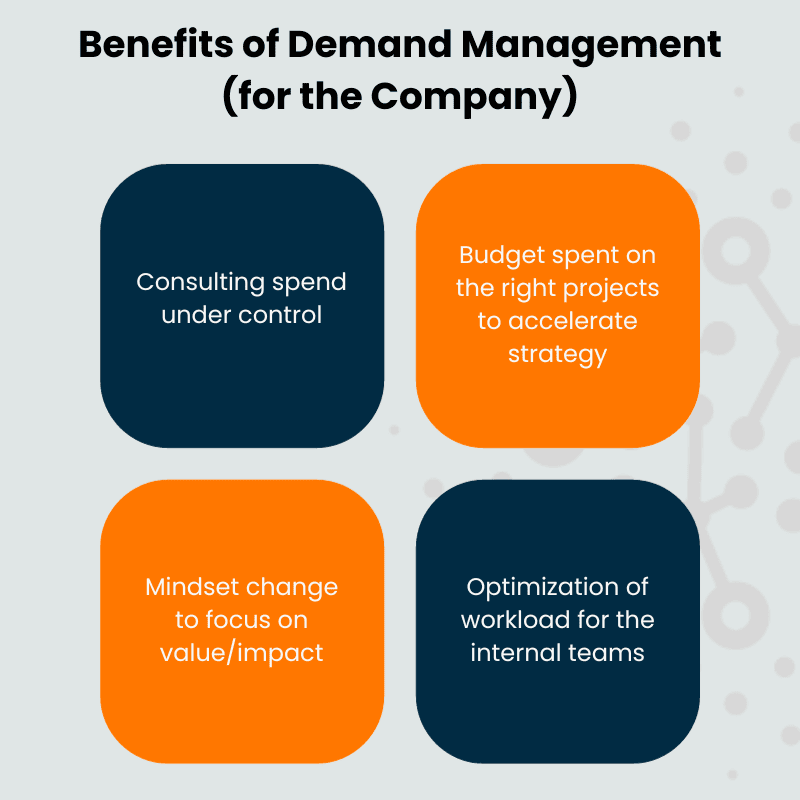Demand management, as a strategic approach, holds immense potential for organizations seeking to optimize resources, drive efficiency, and align financial decisions with their overarching goals. However, like any powerful tool, its effectiveness hinges on proper implementation. To implement demand management right, you must ensure that it is executed correctly, as this can be a catalyst for success, propelling companies toward their strategic objectives.
Yet, there’s a caveat. When demand management is not implemented meticulously, it runs the risk of becoming a liability rather than an asset. Missteps in the process, whether through inadequate stakeholder engagement, rigid systems, or a lack of adaptability, can lead to wasted resources, inefficiency, and missed opportunities.
In this article, we delve into the intricacies of how to implement demand management, exploring the five best practices that organizations must adopt to harness its full potential. These practices are not one-size-fits-all solutions but rather a roadmap to building a robust demand management framework tailored to each organization’s unique needs and circumstances.
Join us on this journey as we uncover the pitfalls to avoid and the strategic steps to take, ensuring that demand management becomes a powerful ally in the dynamic world of modern business while helping you implement demand management.
1. Assess Organizational Readiness and Start Incrementally
What Does It Mean
Before diving headfirst into how to implement demand management, take a step back. Assess your organization’s readiness for this significant shift. This means evaluating where your organization currently stands, acknowledging its strengths and weaknesses, and plotting a strategic path forward. Instead of aiming for an immediate transformation, envision a series of achievable milestones.
Why It’s Important
Implementing demand management isn’t just about adopting a new system; it’s about preparing your organization for sustainable change. Rushing into it without considering your organization’s capacity and the necessary resources can lead to chaos. By starting incrementally, you not only build a solid foundation but also ensure that your team can adapt comfortably.
Best Practice
Begin the demand management journey with a thorough assessment of your organization’s current state. Identify existing processes, available resources, and potential obstacles. Craft a phased approach that aligns with your organization’s current capabilities.
As your team becomes more proficient, gradually expand the scope of demand management practices. This strategic approach prevents overwhelming your team and facilitates a smoother transition into a more advanced demand management system.
2. Engage and Educate Stakeholders
What Does It Mean
Implementing demand management isn’t a top-down decree; it’s a collaborative effort. To successfully navigate this transformation, engage with stakeholders at all levels of the organization. This involves explaining the changes, convincing them of the benefits, providing the necessary training and guidance, and making individuals accountable for their roles in the process.
Why It’s Important
Resistance to change is a common obstacle during any significant organizational shift. By gaining buy-in from stakeholders, you can significantly reduce resistance and create a smoother transition. The success of demand management hinges on how well it’s embraced across the company, making stakeholder engagement a critical factor.
Best Practice
Conduct informational sessions, workshops, or training programs to educate stakeholders about demand management. Emphasize how it benefits not only the organization as a whole but also individual roles and responsibilities.
Proactively address any concerns or questions that arise and provide ongoing resources for learning and adaptation. It’s also essential to clearly define the new rules, outline the decision-making processes, and ensure accountability. Support from top leadership can further facilitate this transformative journey.

3. Opt for an Integrated Technology Solution
What Does It Mean
In today’s digital age, manual processes can lead to inefficiencies and disjointed operations. Opting for an integrated technology solution involves investing in a demand management software or tool that centralizes and automates workflows. This platform should seamlessly integrate with existing systems, offering scalability, user-friendliness, and real-time data analytics.
Why It’s Important
Managing demands across various units and functions requires a consolidated view. Relying on scattered and disconnected processes can result in inconsistencies and inefficiencies. An integrated technology solution ensures that all aspects of demand management are accessible in one centralized location. This is crucial for maintaining control over spend, streamlining operations, and fostering consistency.
Best Practice
Research and select a demand management software or tool that aligns with your organization’s specific needs. Consider specialized options tailored to consulting for instance. Additionally, ensure the chosen solution offers user-friendly interfaces, scalability to accommodate growth, and robust real-time data analytics capabilities. Following industry best practices will help guide your decision in selecting the most suitable tool.
4. Prioritize Flexibility and Adaptability
What Does It Mean
While implementing demand management, it’s crucial to prioritize flexibility and adaptability. A rigid system can quickly become outdated in a continuously evolving business landscape. Demand management processes should be designed to adapt to changing business needs, industry developments, and evolving strategies.
Why It’s Important
Consulting is a versatile field, and the needs of your organization can change rapidly. A rigid demand management system can become a bottleneck in decision-making and hinder responsiveness to new challenges and opportunities. By prioritizing flexibility, your organization can maintain agility and respond effectively to shifting priorities and market dynamics.
Best Practice
Regularly review and update your demand management process. Encourage feedback from users, stakeholders, and decision-makers. Be open to making adjustments based on changing business needs, lessons learned from past projects, and emerging industry trends.
Building adaptability into your system from the start ensures that it can evolve with your organization’s requirements and stay aligned with strategic objectives. Agility and responsiveness should be core principles of your demand management approach.
5. Establish a Feedback Loop
What Does It Mean
Establishing a feedback loop is crucial for continuous improvement in demand management. It involves regularly gathering input and insights from various teams and stakeholders to identify areas for enhancement and promptly address them.
Why It’s Important
Continuous improvement is the key to long-term success. Without feedback and the willingness to act on it, organizations may miss opportunities for optimization and risk falling behind in an ever-evolving business landscape. A transparent and responsive feedback loop can foster a culture of learning and adaptation.
Best Practice
Schedule regular check-in sessions with different teams and stakeholders involved in the demand management process. Create a safe and open environment where they can share their challenges, successes, and suggestions. Act on the feedback received by refining processes, offering additional training, or making necessary system upgrades. Demonstrating a commitment to continuous improvement and responsiveness will contribute to the success of your demand management initiative.
Conclusion: Building a Strong Foundation to Implement Demand Management
Implementing demand management is a journey that organizations must tailor to their unique needs and circumstances. What proves effective for one organization may not necessarily work for another. However, by adhering to these best practices, companies can lay a robust foundation for a demand management system that not only drives efficiency but also minimizes waste and propels them confidently toward their strategic objectives.
Through a methodical approach that includes assessing organizational readiness, engaging stakeholders, adopting integrated technology, prioritizing flexibility, and establishing a feedback loop, companies can position themselves for success.
By embracing these practices and continuously refining their demand management processes, organizations can navigate the ever-changing terrain of modern business with confidence, efficiency, and unwavering focus on their strategic vision.
Demand management is not just about cost control; it’s about maximizing value, optimizing resources, and fostering a culture of continuous improvement. With the right framework in place, organizations can harness the full potential of demand management, ensuring they are well-equipped to seize opportunities and overcome challenges in the dynamic world of business.
implement demand management implement demand management implement demand management
implement demand management implement demand management implement demand management
implement demand management implement demand management implement demand management

How Consource Can Help?
With Consource, implement demand management with ease and quickly approve demands with fully customized workflows based on amounts, capabilities, or cost centers. Secure alignment with your strategy, and avoid redundant buys, all the while relishing completely automatic processes.








0 Comments